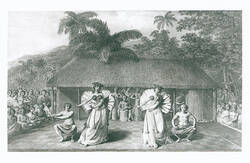Further Media
Producer unknown to us
Oceania, Polynesia, Tahiti/Society Islands (Moorea, Huahine, Raiatea, Taha'a)
Before 1781
Hibiscus fiber, coconut fiber
Acquired in 1773–74 or 1777 on Captain James Cook’s second or third expedition in the Pacific. It is yet unknown by whom the object was acquired.
Brought from Great Britain to Germany by Benjamin La Trobe, a Moravian working in London.
Inv. no. 68692
In Tahiti and the Society Islands, a plant fiber apron was the typical costume for dancers during Hiwas, the Polynesian dance, theater and ceremonial performances. The basic material used to make the dance apron was usually purau fiber (Hibiscus tiliaceus), which was wrapped in bundles around a plant fiber cord braided from two strands and knotted.
In ceremonial Hiwa dances, the hip apron was complemented by other garments, including a poncho-like top made of tapa – the Tahitian bark bast fabric – and a bonnet (tamau) filled with fragrant flowers, braided from strands of human hair and thus “charged” with mana – the divine energy of the ancestors – in the spiritual imagination of Polynesians. A dancing apron of the 'ahu more type was therefore an indispensable regalia for these spiritual ceremonies.
The Herrnhut Dance Apron was probably acquired on the island of Raiatea, 200 kilometers northwest of Tahiti, where Captain Cook dropped anchor in July 1769, September 1773, June 1774, and November 1777. On Raiatea, the spiritual, political and cultural center of the Society Islands at that time, the Marae Taputapuatea, the most important temple to the god of war 'Oro in Polynesia, was operated 250 years ago. From here, the aristocratic cult lodge of the arioi regularly set out on overseas canoe trips through Oceania to spread the 'Oro cult with festive ceremonies and hiwas. In this context, Cook and his companions were most likely to have the opportunity to acquire Hiwa regalia such as a dance apron on the island of Raiatea.
